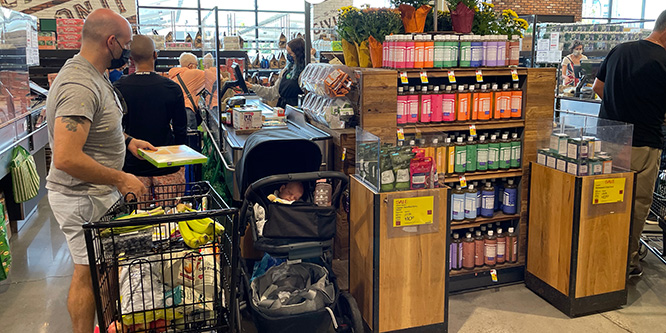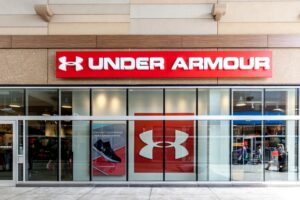
Photo: RetailWire
November 10, 2021
Should retailers take prices higher?
A survey of top retail executives finds 59 percent planning to pass on the costs of supply chain disruptions to consumers. Thirty-six percent were planning to absorb the hit and keep prices consistent.
The survey of 51 senior-level executives fielded in October 2021 by First Insight in partnership with the Baker Retailing Center at The Wharton School found 68 percent expecting a margin hit of less than a 10 percent, but 27 percent saw a reduction of 10 to 20 percent, and five percent, more than 30 percent.
Overall, 65 percent of respondents indicated they were changing their pricing in response to inflation.
Asked how they are deciding where and how much to increase pricing, the top responses were:
- Cost-based pricing/passing along the cost increases, 33 percent;
- Leveraging market data, 25 percent;
- Eliminating or reducing planned promotions, 22 percent;
- Voice-of-customer data/consumer feedback, 20 percent.
The survey comes as vendors on third-quarter analyst calls expressed optimism that surgically raising prices would support their margins while maintaining value across their brands.
James Quincey, CEO at Coca-Cola, said on Oct. 30, “Recent price actions to offset higher input costs have been effective, with lower-than-expected price elasticities to date, and promotional levels remain below 2019.”
Alan Jope, Unilever’s CEO, said on Oct. 28, “There is more pricing still to come, but our pricing actions are thoughtfully planned and carefully executed. We expect a net benefit to topline from the pricing actions that we’re taking.”
Andre Schulten, Procter & Gamble’s CFO, said on Oct. 19, “We expect pricing to be a larger contributor to sales growth in coming quarters as more of our price increases become effective in the market. As this pricing reach[es] the store shelves, we’ll be closely monitoring consumption trends. While it’s still early in the pricing cycle, we haven’t seen multiple changes in consumer behavior.”
On Wayfair’s quarterly call on Nov. 6, Niraj Shah, CEO, remarked about the online home furnishing retailer’s pricing strategy. “What we’re focused on is how do we make sure the customers stay on our platform and the price levels aren’t such that they want to leave and go elsewhere.”
- Retailers Expect Holiday Shopping Shortages, Higher Prices – First Insight
- The Procter & Gamble Company (PG) Q1 2022 Earnings Call Transcript – The Motley Fool
- Unilever PLC (UL) Q3 2021 Earnings Call Transcript – The Motley Fool
- Coca-Cola (KO) Q3 2021 Earnings Call Transcript – The Motley Fool
- Wayfair inc (W) Q3 2021 Earnings Call Transcript – The Motley Fool
Discussion Questions
DISCUSSION QUESTIONS: What would be your advice about when to absorb input costs versus passing them along to customers? How should retailers decide where and how much to increase pricing in the current environment?
Poll
BrainTrust
Carol Spieckerman
President, Spieckerman Retail
Matthew Pavich
Sr. Director Retail Innovation at Revionics, an Aptos Company
Ananda Chakravarty
Vice President, Research at IDC
Recent Discussions







One thing we know for certain is that prices are going to go up. Every retailer will need to work through the dynamics of pricing changes as it relates to their competitive positioning, buying power and cost structure. However with inflationary pressure, wage pressure and additional costs resulting from the pandemic, unless retailers are willing to take a huge hit to profitability, I don’t see how general price increases aren’t inevitable.
You left out the most important option: private label! It’s a win/win — preserve the margin and keep prices reasonable.
In CE retail raw material prices are rising, container tariffs skyrocketed, and availability on the shelf will further decline due to increasing demand. For sure, prices have to and will go up for the consumer.
Price increases will happen – pay now or pay later. Trying to absorb them at the retail level might gain some short-term benefit, but it ignores the needs of the business and its share-holders. Better to find ways that add value to the overall experience.
Show me a retailer that will willingly absorb cost increases to the detriment of their own profitability, and I’ll show you a pig that can fly. That sounds like a PR machine working instead of the harsh reality of dwindling margins.
Of the four options presented, three should have been implemented long ago as a matter of conducting everyday business. Only cost-based pricing will ensure that retailers make a profit and consumers pay the lowest possible price in an inflationary economy.
The trifecta around this topic is inflation, scarcity and pricing power. The general thought is that the companies with the strongest pricing power will be the winners.
If the core of what makes you remarkable is your value positioning in everyday type essentials, any material price increases should be approached very cautiously and only undertaken if there is a strong belief that cost pressures will be pervasive among the competition and comparatively long-lived. If the core of what makes you remarkable is the story you help customers tell about themselves and you sell a want, chances are you serve a more affluent customer and folks are relatively price insensitive to what you offer. There it’s a lot easier to preserve market share, share of wallet and margin.
It’s going to be unavoidable. The distributors that we work with are seeing higher logistics fees and the suppliers are seeing higher raw material costs. The amounts will be slow to grow but it will all be passed along to the end consumer in time.
Keep prices reasonable and in relation to each other, but don’t take the full hit yourself as a retailer. Everyone is expecting prices to rise a bit, so let them rise a bit. As Paula says, private label opportunity time, perhaps.
We are in some uncharted waters with regards to supply chain availability and costs, and the predictability of demand. Retailers have to explore every avenue available to protect their margins and profitability. There will be lots of moving targets for at least the next year, so retailers are going to have to be very nimble with how they execute pricing. Most years the end of January finds many retailers with an abundance of unsold seasonal inventory. Let’s see if this year’s inventory shortage can help clean that up. Or will late arriving inventory cause more of a January glut than ever? That would be a disaster on top of the higher prices paid to finally get the inventory on the floor. Absolutely retailers need to test and explore every opportunity to recoup costs with higher prices.
Pricing decisions are driven by two key factors, cost and competition. I would advise all companies to not absorb supplier price increases but pass them on to the customer. If competitive pressures are such that it becomes a decision to raise prices or lose business, the decision is much more difficult.
If each company in a competitive sphere holds prices because the other guy is doing it, the only result is that all companies in that sphere become less profitable.
These decisions are often made with the thought that holding prices will gain volume from the other guy. That is true, except if the other guy matches. Then all the companies have done is lose margin against no gain.
Retailers need to dissect a few things while reevaluating their pricing strategy to offset supply chain disruption costs. Increasing prices may not be the only way to offset costs. Rethinking the way we retail is critical and imperative in a landscape that is pushing sustainability and customer-centricity.
A few ideas:
Price increases could lose you customers. And that’s the reality.
Retailers have many tools at their disposal to ensure that price adjustments are surgical rather than sweeping. Many of the majors have doubled down on private brands and hired, partnered with, or purchased, data and pricing expertise to make it happen. Retailers don’t have to absorb all price increases and can exert pressure on suppliers to share the burden. Throw in the reality that scarcity may overtake price pickiness this holiday and there are many mitigators to price-based pushback.
Pricing is going to be a more tricky than usual operation for the next year or so, especially for retailers getting most of their sales from physical stores. Shoppers now have apps that search retail sites to determine where the best prices are. The advanced apps even let you look at a market basket of goods to determine the most price-effective shop. This is creating both challenges and opportunities for retailers, many of which are now spending a lot of resources scraping the prices of competitors off the internet to incorporate that data into their pricing analytics platform. It’s a vicious circle and the winners will be the companies with algorithms that recommend price increases that don’t piss off shoppers.
With the announcement today of a 6.2 percent increase in consumer prices, the issue is not if prices should be raised. Rather the focus should be on timing and amounts. While consumers will be expecting price increases, they will be sensitive to any perceived price gouging. This represents a terrific opportunity to develop a non-price differential. Let’s get creative.
Retailers will have a delicate balancing act to do, for which they need to be data-savvy. With the ultimate goal of balancing sales and profitability, they need to determine which products have more price elasticity so that they can pass on the costs, which products they can promote together to maintain overall margin, and which products for which they cannot afford to pass on the costs.
It’s not easy at all, and this capability cannot be acquired overnight. I expect retailers who have been data-savvy to excel at this, while the rest take a rather simplistic approach that will invariably hurt their sales and margins.
This is a really tough one and it depends on how long the problems will last. Knee jerk reactions could be a problem, creating accusations of profiteering by the media, but over time retailers will have to gradually increase prices to reflect what they are seeing and their increased costs — otherwise their margins will suffer and shareholders will be upset.
Reports suggest that the issues in supply chain and raw materials are not going away soon so acting now – albeit gradually – would makes sense.
Consumer inflation is often higher in reality than official figures suggest. There are multiple reports in the media that many developed nations are in for a sustained period of higher inflation – higher than it has been for the last 20 to 30 years. This should not be a surprise to anyone with even the slightest interest in economics given the amount of money governments have pumped into the economy during the pandemic. There has been talk about central banks not moving fast enough with interest rate changes – they are caught between the need to control inflation and consumers who are being squeezed in other ways.
Whatever happens, the next 12 to 36 months are going to squeeze retailers and consumers alike.
No doubt prices will continue to rise as inflationary pressures build and supply chain disruptions become even more problematic. It’s really unfortunate, but I don’t see any retailers or CPGs not making this move. If they did, it would result in a gigantic hit to their overall profitability. The key for management is to optimize their mix of in-house brands with CPG brands to maintain customer engagement and loyalties during a tough stretch.
Companies could take a margin hit if rising costs are expected to be short-term and account for a small portion of their assortment. They also need deeper pockets. Cost-based pricing works for higher expenses over the longer term and for a greater proportion of a product line.
More retailers and brands now use analytics to watch rivals’ price fluctuations and consumers’ price elasticity. By monitoring market moves, companies can spot patterns and optimal price points that protect profitability.
Only the largest retailers (say, Amazon and Walmart) can absorb price increases in the interest of their market share battle with each other, but this only goes so far if their suppliers are facing their own pricing pressures. The combination of labor scarcity and supply chain disruptions is tough for most retailers to overcome, but it still pays to present some sort of value proposition to your customers.
A real-life example: Our local Subaru dealer (the largest in Wisconsin) normally gets an allocation of 400 new cars per year. In 2021, their allocation was reduced to 50-60 cars. They have no choice but to sell these cars for MSRP, to recover in margin what they can’t produce in sales volume.
Most consumers understand the pressure on costs that retailers are facing. There has been a lot of talk of inflation coming back so it is a time when retailers can protect margins with higher prices. However what they must be careful about is being seen to be taking advantage of the situation and misleading their consumers. Several brands recently reduced size of the product rather than increase the price. This is not a wise move as it annoys consumers who think they are being taken advantage of. Similarly, if retailers increase price then promote an item back to the old price there is a feeling of deception, all of which is not good for long term customer satisfaction and brand loyalty.
Yes – they should take prices up. And yes they should keep prices the same. Also, yes they should take some prices DOWN. It’s not a simple, binary solution and a classic “my costs went up therefore my prices need to go up” approach across the board is a recipe for failure.
The best retailers are using a balanced approach and looking at the data and analytics to best understand where to take prices up and where to hold or actually decrease prices. This is a win-win for both retailers and consumers as consumers get better prices or minimal cost increases on KVIs and other items important to them and retailers grow share while also increasing profits.
Sophisticated pricing platforms have shown tremendous results this summer across the board, for all retail verticals and regions impacted by inflation. If you’re a retailer who is still just “maintaining margin” or increasing all prices by x percent across the board — get ready for share loss. It’s already happening.
Inflation is so hefty and persistent that shelf-edge prices have to rise. Some manufacturers and suppliers I have spoken to are facing up to 40 percent-plus increases for some of their input costs. There is no way that suppliers and retailers can absorb all of this. The good news is that the competitive nature of retail means inflation will not be passed across in whole to the customer. Nor will price rises be the only strategy: pack shrink, changes in quality, trying to shift the mix of what is sold, and other tactics will be used to address the cost issues.
Price hikes are going to be inevitable for almost all retailers, but the lazy approach is to just accept that. I’d like to see brands really push to find long-term solutions that make them less reactive to the challenges the industry currently faces because they aren’t going away any time soon.
I interviewed a manufacturer who was forced to raise prices because of the increase in parts he was using in the products he sold. He simply shared with his customers the reason for the price increase. He explained that if they go down, he would lower them. He appealed to their logical side and it worked. He didn’t lose any business – at least because of the increase.
Don’t surprise customers with higher prices. Explain why. You might be surprised how they react (in a positive way).
As a retailer, we have had do market and competitive analysis and unfortunately we have had to raise prices based on vendor costs and changes in the labor market. We carefully did this so it would not give our customers sticker shock. As most retailers will do, we will continue to monitor the market and adjust accordingly.
Manufacturers are thinking the same thing about passing on costs to distributors and retailers. Mapping price elasticity, accurate forecasting and product specific demand curves will be key to separating individual product lines and how much you can change price. It will be no free for all for retailers — whether they put the pressure downstream or upstream. Those who can negotiate best with their customers and suppliers will come out ahead. Those who decide to just push everything in one bucket will find there are many leaks in the bucket.
The decision to absorb input costs versus passing them along to customers should be based on the products in focus.
In case of essential items, most of the retailers already price their products at cost or in certain cases below cost. And I am confident that they will continue to do so even if input costs rise. Such a pricing approach serves two purposes: it makes vital supplies available to everyone while also driving customers into stores to buy other products.
On the other hand, for non-essential items, retailers must respond to higher costs by increasing the prices of the products for the end consumer. Customers purchase such things only when they are prepared to spend such a large sum of money and have the financial means to do so.
Moreover, higher prices can discourage impulse buying from consumers. When consumers choose consciously, they reduce excessive consumption, saving resources and wastage. Who knew pricing can also help sustainability?
All of the comments have a ton of validity to them, and also paint a clear picture of the challenges to retail today. I do think that most retailers are merchants that will look with careful eyes at initial and maintained margins and product turn, along with their consumer’s actions. What a challenge!